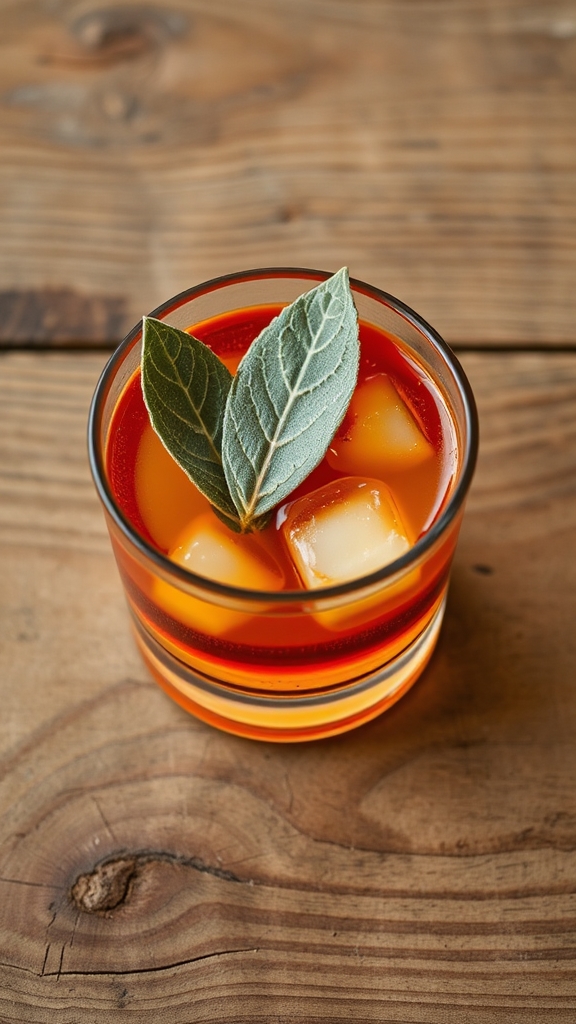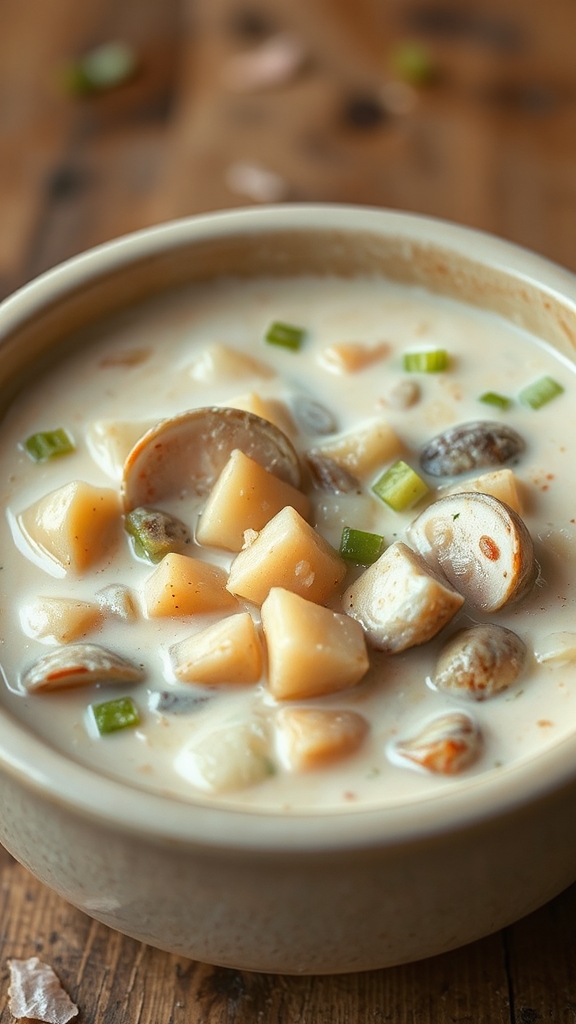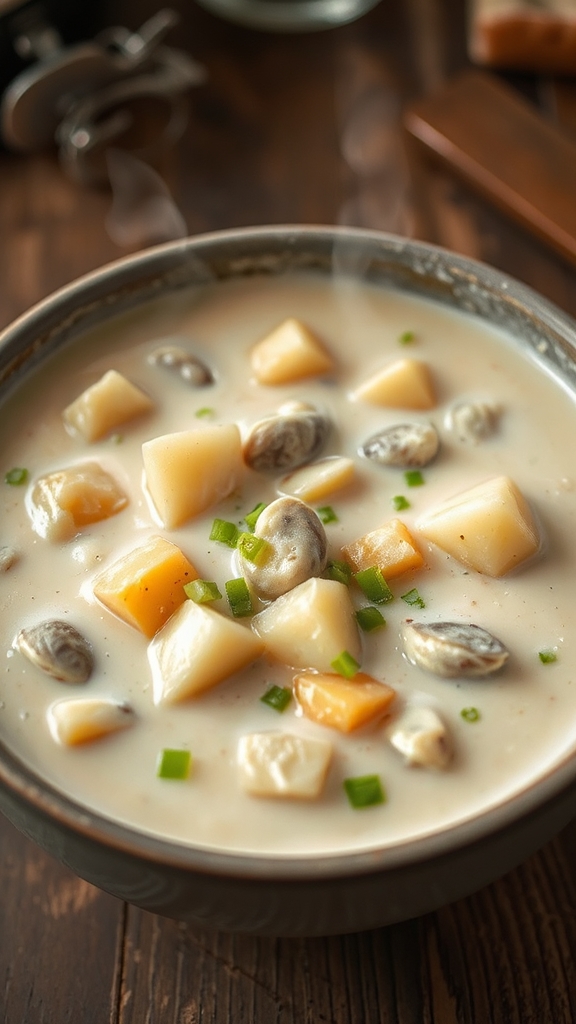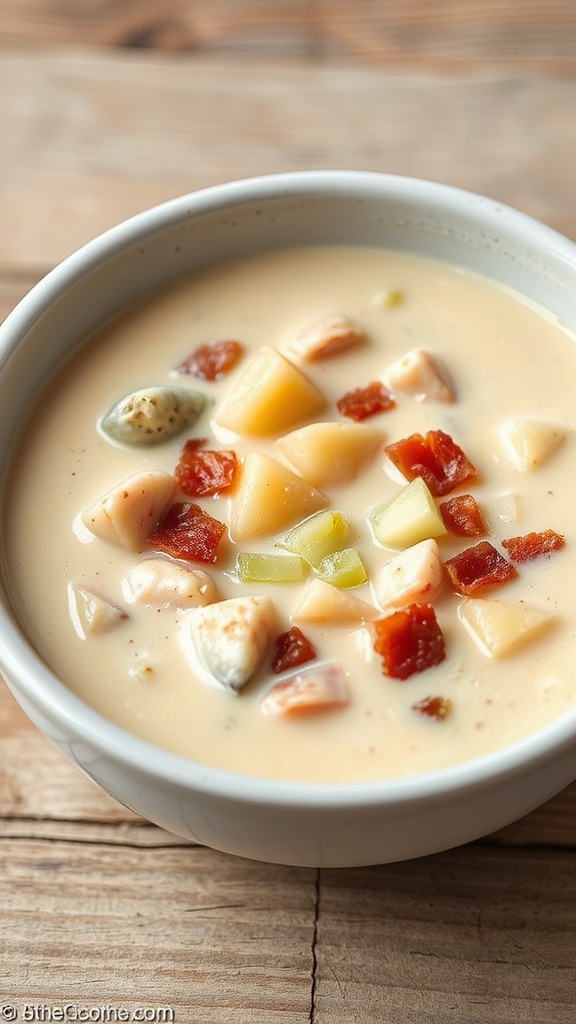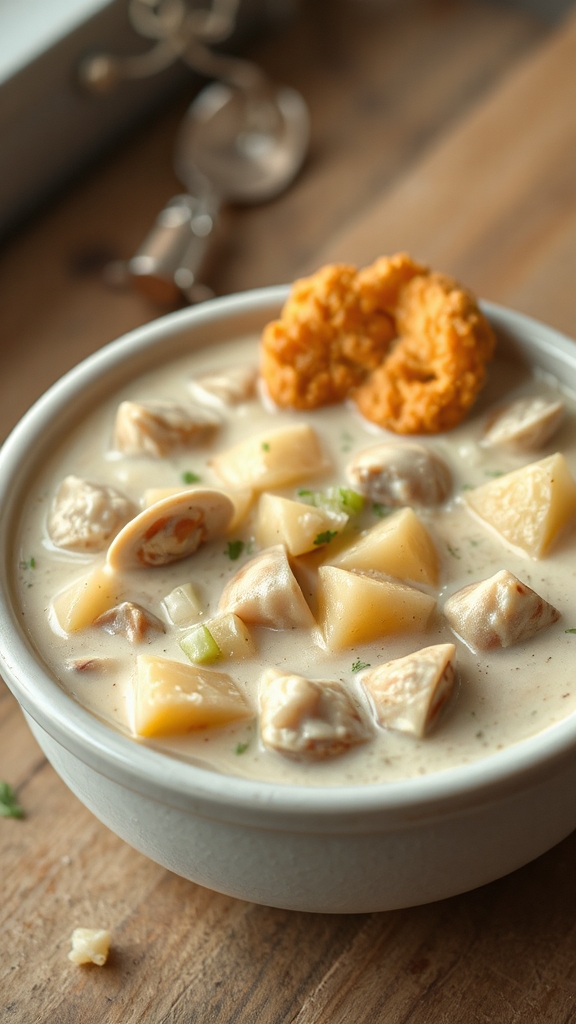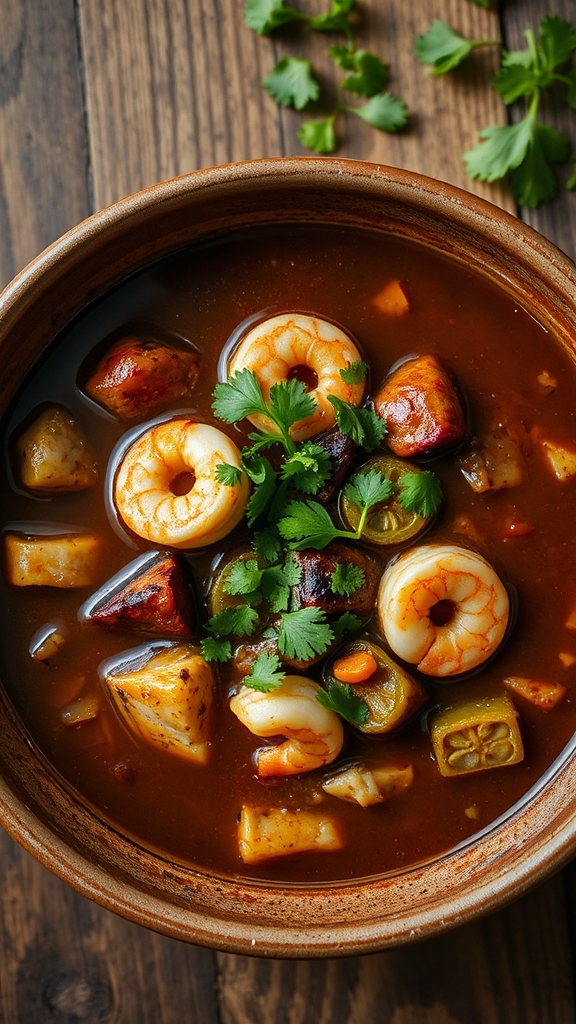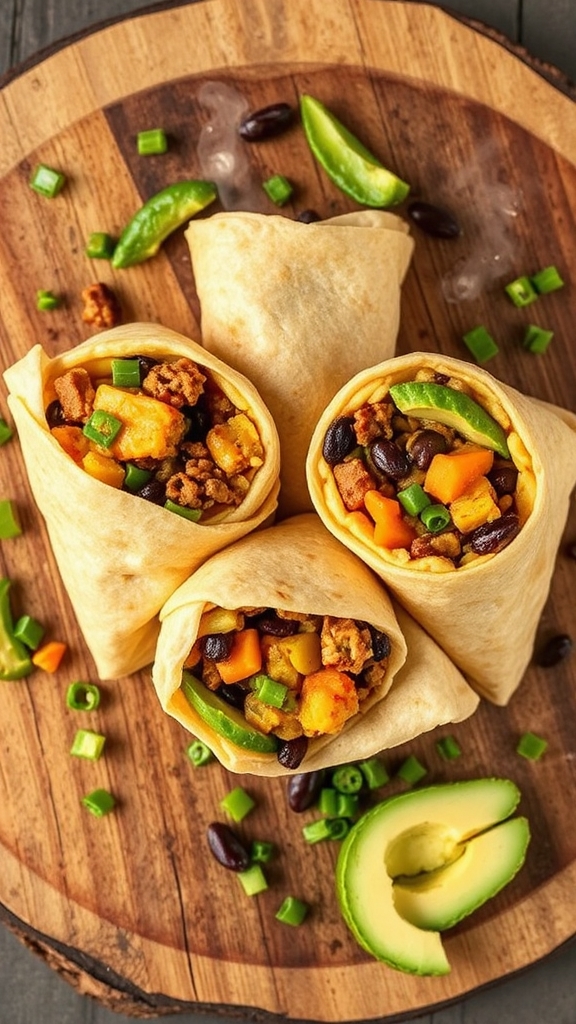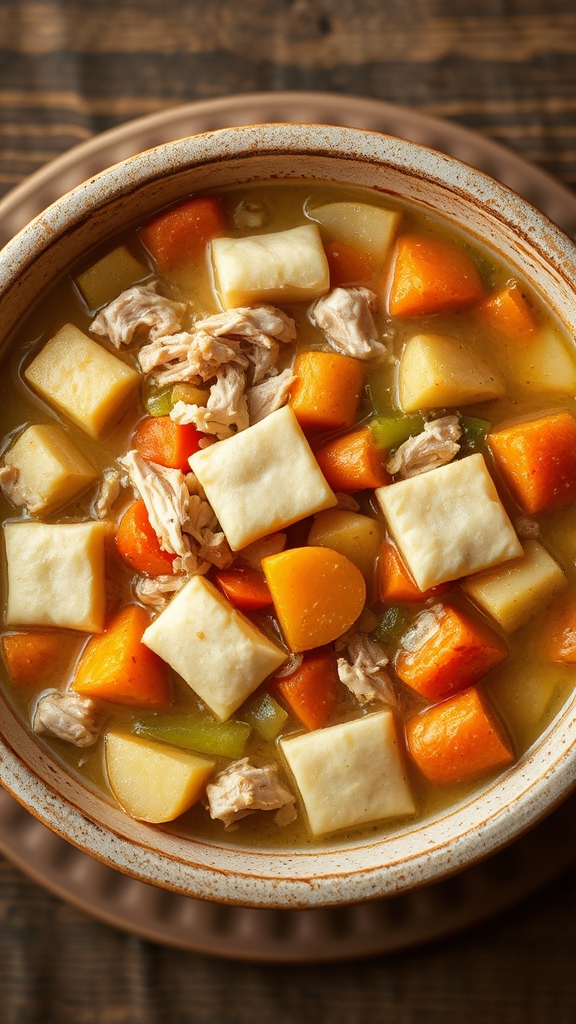Freezer-Friendly New England Clam Chowder
Learn how freezer-friendly New England Clam Chowder simplifies your meals, and discover variations that'll elevate your next bowl.
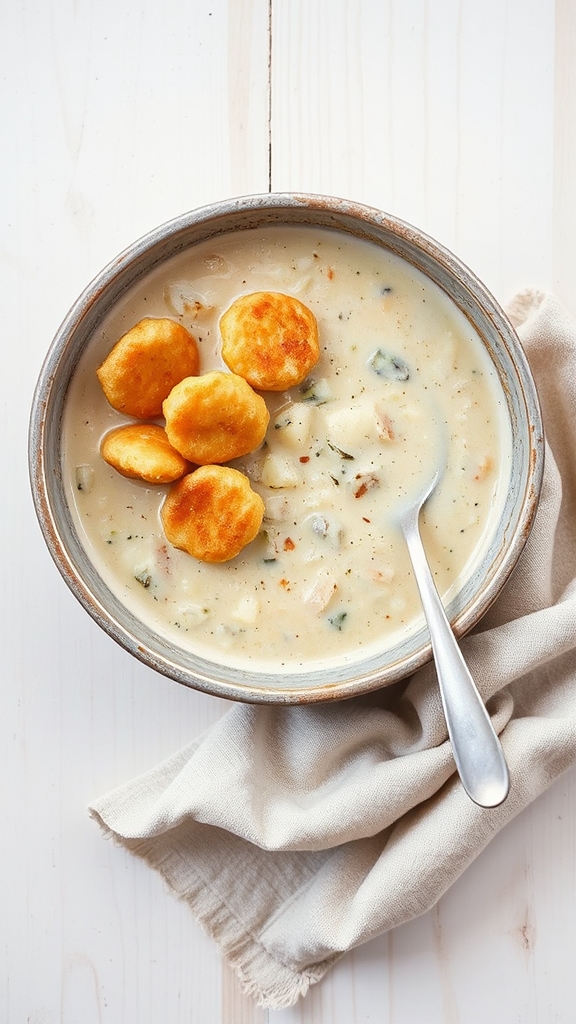
I make freezer-friendly New England Clam Chowder that’s a breeze to whip up and store for those hectic days. I start with fresh clams, diced potatoes, onions, celery, and bacon, cooking them into a creamy, hearty base in one pot. Once it’s done, I cool it quickly and freeze in airtight containers for up to three months—reheating’s as simple as thawing and warming on the stove. Stick around for my tips on variations that’ll take this classic even further.
History
New England Clam Chowder originated in the coastal regions of New England in the United States, evolving from early Native American and European settler traditions that emphasized fresh seafood and hearty ingredients for sustenance in harsh climates.
Regionally, it contrasts with versions like Manhattan Clam Chowder, which uses tomatoes instead of cream, highlighting New England’s creamy style as a symbol of its maritime heritage and preference for rich, comforting flavors.
Traditionally, this dish is served at family gatherings, seafood festivals, and casual coastal meals, often evoking a sense of community and nostalgia for the region’s fishing culture.
Ingredients
– Fresh or Canned Clams: Oh, you know, these little guys are the heart and soul of any good New England Clam Chowder, right?
Go for about 2 pounds of fresh clams if you’re feeling fancy, or a couple of 10-ounce cans when life’s in a rush—drain them well, because nobody wants that extra liquid throwing off your creamy vibe.
And isn’t it funny how one simple ingredient can make a soup feel like a seaside adventure?
– Potatoes: Let’s talk spuds—grab around 4 medium-sized russets or Yukons, peeled and diced into bite-sized chunks, because who doesn’t love that hearty, stick-to-your-ribs texture that soaks up all the flavors?
They’re like the unsung heroes here, quietly bulking things up without stealing the show.
And I often wonder if potatoes are nature’s way of saying, “Hey, add me to everything for a little extra comfort.”
– Onions: A couple of large yellow Onions, finely chopped—say, about 2 cups worth—because they’re the base that builds all that savory goodness, adding a sweet, subtle punch that wakes up your taste buds.
Ever notice how chopping onions can make your eyes water like you’re telling a sad story?
It’s that everyday magic that keeps cooking fun, even on a frazzled day.
– Celery: Don’t skip this, about 3 stalks diced up nice and small, as it brings a fresh, crunchy contrast to the creamy mix—think of it as the sidekick that adds a hint of brightness without overwhelming the crew.
You might chuckle at how something so ordinary can elevate a dish, like when you realize celery‘s just veggies doing their best impression of a flavor enhancer.
– Bacon or Salt Pork: For that smoky depth, snag 4-6 ounces of bacon, chopped, or some salt pork if you’re channeling old-school vibes—cook it first to render out the fat, because what would chowder be without a little indulgence?
It’s like borrowing a touch of indulgence from the piggy bank, and hey, who am I to judge if you sneak a crispy piece while prepping?
– Butter: A generous 4 tablespoons of unsalted Butter, melted into the pot for that rich, golden base—it’s the stuff that makes everything cozy, almost like a warm hug in ingredient form.
Sometimes I think about how butter turns simple into spectacular, in that playful way it smooths out the edges of a recipe.
– All-Purpose Flour: About 1/4 cup for thickening, whisked in to create that perfect, velvety consistency without any lumps—because, let’s face it, nobody wants a watery soup when you’re aiming for freezer-friendly comfort.
It’s a bit like that reliable friend who shows up to fix things, and I always find myself muttering, “Flour, you’re the unsung thickener we all need.”
– Heavy Cream or Whole Milk: Here’s where it gets creamy—use 2 cups of heavy cream for ultimate richness, or whole milk if you’re keeping it lighter, as this is what gives New England style its signature hug.
You might ponder, is there anything more satisfying than stirring in that dairy dream, turning a simple mix into something you’d want to cozy up with on a chilly night?
– Clam Juice: Add in a 8-ounce bottle for extra flavor depth, because why not amp up that oceanic essence?
It’s like the secret whisper that makes your chowder taste authentically briny, and in a self-deprecating moment, I’ve to admit, I sometimes forget it until the last second, but that’s cooking for you—full of little oopsies.
– Seasonings: A mix of salt, pepper, and maybe a bay leaf or dried thyme—start with 1 teaspoon salt and 1/2 teaspoon pepper, adjusting as you go, because Seasonings are the fine-tuners that make or break the harmony.
Isn’t it wild how a pinch here and there can turn good into great, like they’re the recipe’s built-in punchline?
– Optional Add-Ins for Freezer-Friendliness: If you’re prepping ahead, toss in a splash of lemon juice or some frozen corn for texture—say, 1/2 cup—because freezing can mute flavors a bit, and who wants a bland bowl when you thaw it out?
It’s that thoughtful extra, like packing a snack for a road trip, just in case.
Cooking Steps
To kick things off with this hearty soup, start by grabbing your 4-6 ounces of bacon or salt pork and cook it in a large pot over medium heat until it’s crispy and has rendered out that golden fat—think of it as the sneaky ingredient that adds a smoky whisper to every bite. Once that’s done, toss in about 2 cups of finely chopped yellow onions and 3 stalks of diced celery, sautéing them until they’re soft and fragrant, which usually takes around 5 minutes. It’s amazing how these veggies turn from humble beginnings into the flavorful foundation that makes the whole dish sing, isn’t it, like they’re putting on a little show in your pot?
Next, stir in 4 tablespoons of unsalted butter to melt with the veggies, then sprinkle in about 1/4 cup of all-purpose flour to create a roux that thickens things up nicely—whisk it smoothly to avoid any lumps, because nobody wants a soup that feels like it’s playing hide-and-seek with your spoon. Add your 2 pounds of fresh clams or drained canned ones, along with diced potatoes from 4 medium russets, and pour in enough clam juice or broth to cover everything, bringing it to a gentle simmer. This step is where the magic happens, blending those ingredients into a creamy, comforting mix that promises to warm you up on a chilly day, and you might even chuckle at how something so straightforward can feel like a cozy adventure.
Finally, let the chowder simmer for about 20-25 minutes until the potatoes are tender, stirring occasionally to keep it from sticking—adjust seasoning with salt and pepper to taste, and consider adding a splash of cream for extra richness if you’re in the mood for indulgence. Once it’s cooled, portion it into freezer-safe containers for that freezer-friendly twist, making meal prep a breeze for busy weeks ahead. Who knew a simple soup could be this versatile, turning ordinary ingredients into something you’d look forward to all week?
Tips and Variations
When you’re tweaking your Freezer-Friendly New England Clam Chowder, one handy tip is to experiment with textures by adding a crispy fried element, like golden clam fritters, to contrast the creamy soup—start by heating vegetable oil in a heavy pot to a steady 350°F, using a thermometer to keep things from turning into a smoky mess, because who wants to wrestle with burnt bits when you’re aiming for that perfect crunch.
For variations, swap in smoked sausage instead of bacon for a heartier kick, or go lighter with coconut milk in place of cream for a dairy-free twist that still feels indulgent, and you might just wonder, isn’t it amusing how a few simple changes can make your bowl of chowder feel like it’s got a whole new personality, almost like it’s playing dress-up in the kitchen?
Tools
| Tool | Purpose |
|---|---|
| Large, heavy-bottomed pot or deep fryer | For cooking the chowder base and frying elements like clam fritters |
| Thermometer | To monitor oil temperature accurately during frying |
| Knife | For chopping ingredients such as onions, celery, and potatoes |
| Cutting board | To prepare and chop vegetables safely |
| Measuring cups | For measuring liquids like broth, milk, or cream |
| Measuring spoons | For measuring smaller amounts of ingredients like spices or seasonings |
| Wooden spoon | For stirring the chowder mixture without scratching the pot |
| Slotted spoon | For removing fried items from hot oil |

Hi There! I'm Stephanie Miller: Elementary teacher from Columbus, OH sharing grandma's treasured American recipes! 50 years young, yoga enthusiast & kitchen storyteller. Welcome to my food family! 🍰❤️

